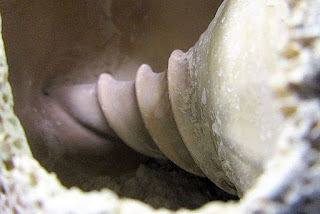kw: natural history, natural science, museums, collections, photographs
A large collection (almost 40,000 shells), donated to the Delaware Museum of Natural History years ago, has been cataloged little by little over the years. At present the Collections Manager and a few volunteers are working with certain fossils, including this immense snail shell. It is a bit over a foot long and weighs a few pounds. The animal must have weighed 20 pounds or more when alive.
The species is Turbinella angulata (Lightfoot, 1786), also known as the West Indian Chank Shell; "chank" comes from a native word for "divine conch". This specimen is a Pliocene fossil collected in Florida, so the animal lived about 5 million years ago. The species is still found in waters off Florida and around the Caribbean and the western Atlantic Ocean.
The many holes in the shell are from calcium-consuming organisms that gradually destroy any shell left lying on the bottom long enough. When you find a shell, or a piece of one, that is ragged and full of holes, it has been on the sea floor for several years or decades. This specimen and those with it were sitting around for some time before an underwater mudflow covered them and preserved them so they could "hang around" a few million years until erosion exposed the fossil beds known as "marl pits" in southern Florida.
This view of the same shell shows that the pearly inner layer is still largely intact, with some of the original pinkish color. The main structure of most mollusk shells is the calcite form of calcium carbonate. A slight change in the chemistry of deposition can produce aragonite instead. Aragonite forms mother of pearl and the smooth inner surface of, for example, clam shells. The mantle of many, many kinds of mollusks can perform this chemical trick to lay down mother of pearl, and also to deposit pearls. Notice also that there are no holes in the pearly lining. Aragonite is a lot harder for the calcium-eaters to attack.
This particular specimen has a chunk knocked out, as you can see at the right. This allows us to view the columella, the central structure that supports the whorls of many snail shells. I gave the shell a quarter turn and played around with light and focusing until I could get a picture of part of the columella, seen here:
This species is characterized by the three spiraling ribs down the columella. Different species have different numbers, so if you can't distinguish which kind of conch you are collecting, you can either x-ray one of the shells, break one open, or if you have a small "borescope camera", spin it up inside and have a look!
The largest shells of this species are more than a foot-and-a-half long, only a little smaller than the largest American snail, the Florida Horse Conch (which is not really a conch; we can dig into that another time).
Subscribe to:
Post Comments (Atom)






No comments:
Post a Comment